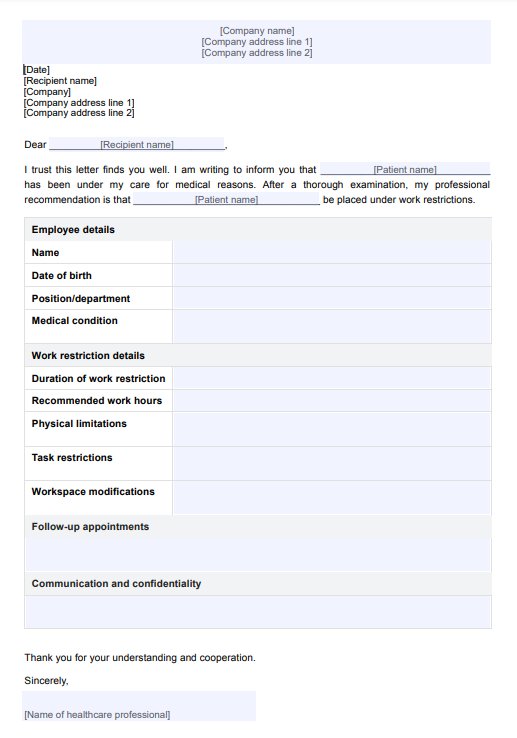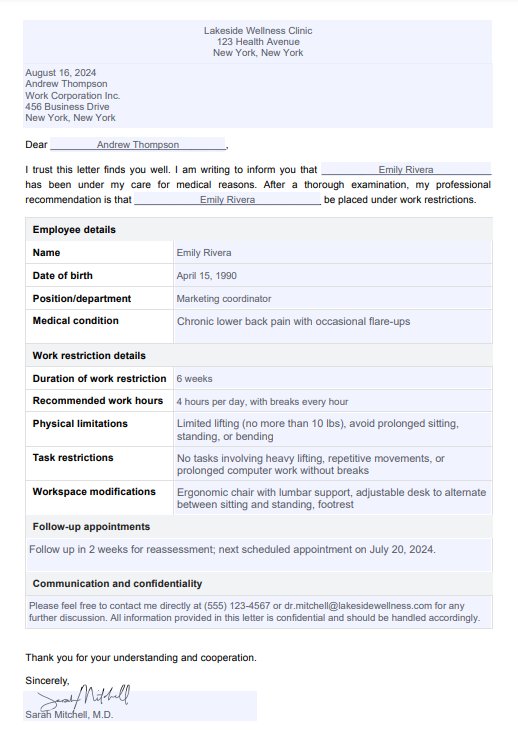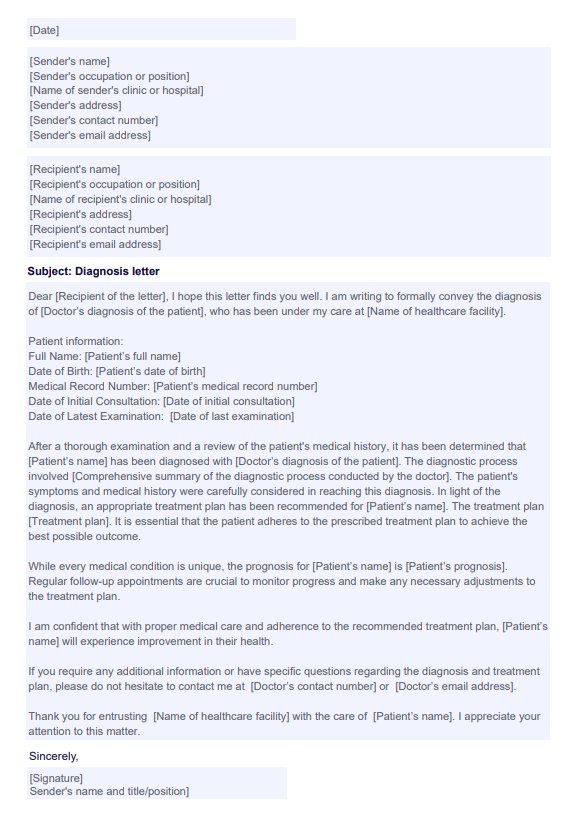Work Restriction Letter from Doctor
Use our free Work Restriction Letter from Doctor template to advocate for reasonable accommodations in line with the employee's limitations.


What is a work restriction letter?
A work restriction letter is typically provided by a medical professional that outlines specific limitations or modifications in an employee's job duties due to a health condition. This letter is a formal communication tool between the healthcare provider, the employee, and the employer or the human resources department, detailing necessary accommodations to ensure the individual's well-being while at work.
More than just a doctor's note, it's documented proof that circumstances require specific considerations, letting injured workers fulfill essential job functions and fulfill work responsibilities without compromising their health. A completed form may also be used for workers compensation claims in the case of a work-related injury.
A work restrictions letter bridges you, your patient, and their employer, ensuring everyone is on the same page.
Work Restriction Letter From Doctor Template
Work Restriction Letter From Doctor Example
Examples of work restrictions
Work restrictions can vary from one employee to another, depending on the diagnosis and recommendation from the doctor. Here are some common examples:
- Reduced work hours: Limiting the number of hours employees work per week to accommodate their health needs, allowing for a balanced work-life approach.
- Job task modifications: Adjusting specific tasks to align with employees' abilities, ensuring they can contribute effectively while managing their health condition.
- Workspace modifications: Altering the work environment by providing ergonomic furniture or adjusting seating arrangements to enhance comfort and accommodate physical limitations.
- Light duty assignments: Assigning less physically demanding tasks, allowing employees to fulfill their responsibilities without straining their health.
- Flexible schedule: Allowing employees to have a flexible work schedule, enabling them to adapt their work hours to suit their health circumstances better.
- Telecommuting or remote work: Allowing employees to work from home, providing flexibility and reducing the need for extensive commuting, especially beneficial for those with health concerns.
- Assistive technology usage: Implementing technology or tools that assist employees in performing their tasks, addressing specific challenges posed by their health conditions.
How do I use this letter template?
The Work Restriction Letter from Doctor template is designed to help an HR manager and employers support employees with medical conditions. Let's break down the steps to make it easy for you.
Step 1: Access the template
Start by accessing the template—click the "Use Template" button to open it in the free Carepatron app, which also lets you customize it. You can also save the printable PDF onto your device by clicking "Download."
Step 2: Fill out details
Complete the necessary information by providing your details, the patient/employee's name and job title, and the employer or HR manager's information. This ensures clear communication and alignment among all parties involved.
Step 3: Understand the medical diagnosis
Read the medical diagnosis carefully. Get a clear picture of what the employee is going through so you can adjust things accordingly.
Step 4: Identify modified duties and responsibilities
Look for changes in job duties. See what tasks can be adjusted to fit the employee's abilities.
Step 5: Specify work environment modifications
Check if there are any changes needed in the workspace. The employee may need a different setup or equipment - note those down.
Step 6: Highlight the expected duration
Know how long these changes will last. It helps you plan and track the employee's progress. Include the date for which the work restriction should take effect. It could be shorter working days or hours.
Step 7: Communicate specific restrictions to employee
Share the details with the employee. Provide clear information and ensure they understand what they can and can't perform.
Step 8: Ensure compliance and regular follow-ups
Keep an eye on things. Check in with the employee regularly to see how they're doing. Confirm they're following the modified plan.
Step 9: Provide support for the worker
Remember, support is critical. Help the sick or injured worker through this period and offer assistance when ready to return to their regular duties. Outline the recovery plans and file their medical records securely for progress tracking. Encourage them to keep in touch with you using your contact details, also provided in the letter.
The outcomes of medical restrictions on work
Understanding the outcomes of medical restrictions on work is crucial for employers and employees. Let's delve into critical aspects, starting with reduced hours.
Reduced hours
Employees work fewer weekly hours when medical restrictions and a modified duty lead to reduced hours. This adjustment is often made to accommodate the employee's ability while ensuring they can continue contributing to the workplace. For instance, an employee may work part-time instead of full-time, allowing them to balance an employee's health needs with job duties.
Shorter workweek
A shorter workweek is another outcome of medical restrictions, providing employees more time for rest and recovery. This adjustment recognizes the importance of allowing individuals to manage their health while still being a part of the workforce.
Shortening the workweek will enable employees to perform their job tasks while navigating the challenges posed by their medical condition, fostering a balanced approach to work and health.
Restricted duties
Medical restrictions may result in employees having specific job duties restricted or altered. This could involve limiting specific physical tasks or modifying job responsibilities to align with the employee's ability. For example, an individual is diagnosed with Lumbar Disc Herniation.
In such a case, a medical restriction might excuse the employee from tasks that involve heavy lifting, like carrying boxes or prolonged periods of sitting, ensuring their well-being and job engagement.
Modified equipment, tools, or workspaces
In some cases, medical restrictions lead to modifications in the workplace environment. This may involve providing specialized equipment or altering tools and workspaces to accommodate employees' needs. For instance, ergonomic chairs or adjustable desks could be introduced to enhance comfort and support for individuals with medical restrictions.
These modifications aim to create a more inclusive and adaptable work environment, aligning with the requirements of the Americans with Disabilities Act (ADA).
Commonly asked questions
Work restriction letters are typically used by employees who have received medical recommendations from their doctors regarding adjustments needed in their job duties.
A work restriction letter should be used when an employee experiences a health condition or injury requiring modifications in their work tasks, letting the employee work safely and ensuring a supportive and compliant workplace.
A work restriction letter is filled out by a healthcare professional detailing specific limitations or accommodations and is then submitted to the employer to facilitate necessary adjustments in the employee's job responsibilities.












































































































